Poster Day 2015
Melissa L. Barnes
Psychology
Advisors: Tricia Waters & Heidi Lewis
Blame toward Women Targets of Acquiantance Rape: Interactions of Gender, Racism, and Sexism
This study explored intersectionality of attitudes toward heterosexual acquaintance sexual assault, specifically blame placed upon Black and Caucasian women targets of rape. Intersectionality theory states social identifiers have an additive effect on discrimination experiences. Black women who are sexually assaulted are affected differently than White women because of their identity as a Black person. A national sample of 296 participants were randomly chosen to read a vignette that was accompanied by one of four sets of pictures, depicting the vignette characters as Black or Caucasian. The Modern Racism Scale and the Ambivalent Sexism Inventory measured racism and sexism, respectively. Victim blame and perpetrator blame were dependent variables written about in the thesis paper; this poster will focus on victim blame. Regression models provided evidence in all vignettes for intersectional accounts of victim blame allocation.
Nick Bernstein
Neuroscience
Advisor: Lori Driscoll
N-terminal EF-Hand Calcium Binding Proteins (NECABs) in Early Development of the Nervous System
Calcium ion (Ca2+) gradients in the brain affect neurotransmitter release, neuronal gene expression, and neurogenesis. Consequently, Ca2+ concentrations inside and outside of cells must be maintained within tight margins both in the adult nervous system and throughout development via Ca2+ sequestration mechanisms, such as Ca2+ binding proteins. In the present study, the developmental expression of N-terminal EF-hand Ca2+ binding proteins (NECAB) 1 and 2 was visualized using immunofluorescence. Both proteins were primarily found in immature neurons in neocortex, thalamus, and striatum, and were dispersed in other structures throughout the developing nervous system. NECAB2's expression pattern began early and was more extensive than NECAB1's. Subsequently, a transgenic NECAB2 knockout (NECAB2KO) mouse model was validated, but further experimentation with the NECAB2KO mouse model will be necessary to elucidate the protein's overarching phenotype.
Jacob Brodsky
Psychology
Advisor: Kevin Holmes
Essentialism of Gender in Monolinguals and Bilinguals: Disentangling Dimensions of Naturalness and Entitativity
Psychological essentialism is the belief that members of a category share deep, unchanging properties. Previous evidence suggests that males are more likely to essentialize than females and that monolingual children are more likely to essentialize than bilingual children. The present research investigated essentialism of gender by monolingual and bilingual adults, focusing on two independent dimensions of essentialism: naturalness (regarding categories as biologically based) and entitativity (regarding categories as homogeneous groups). Participants indicated their agreement with statements assessing beliefs about men and women on the two essentialism dimensions. The results showed that bilinguals were less likely than monolinguals to essentialize gender in terms of naturalness, but that the two groups essentialized gender to comparable degrees in terms of entitativity. The results also replicated previous work showing that males essentialize gender more than females. Together, these findings converge with models of essentialism that highlight the bidimensionality of the construct, and suggest that bilingualism may lead to less rigid categorizations of gender. Structural alignment between languages is discussed as a potential mechanism underlying such changes in categorization.
Melissa Chizmar
Psychology
Advisor: Jason Weaver
Enjoy Life… This Is Not a Dress Rehearsal:
The Role of Play in Adulthood
The importance of play in adulthood is examined through the lens of positive psychology. Background information as to the nature of play and its role in human development is provided. Special attention is paid to the proposed immediate benefits of play to the individual, including physical health, stress coping, positive relationships, and creativity. Differences and similarities between related constructs-e.g., playfulness, flow, leisure, work, intrinsic motivation-are also outlined. Play is found to be advantageous across the lifespan.
Kjersten Conway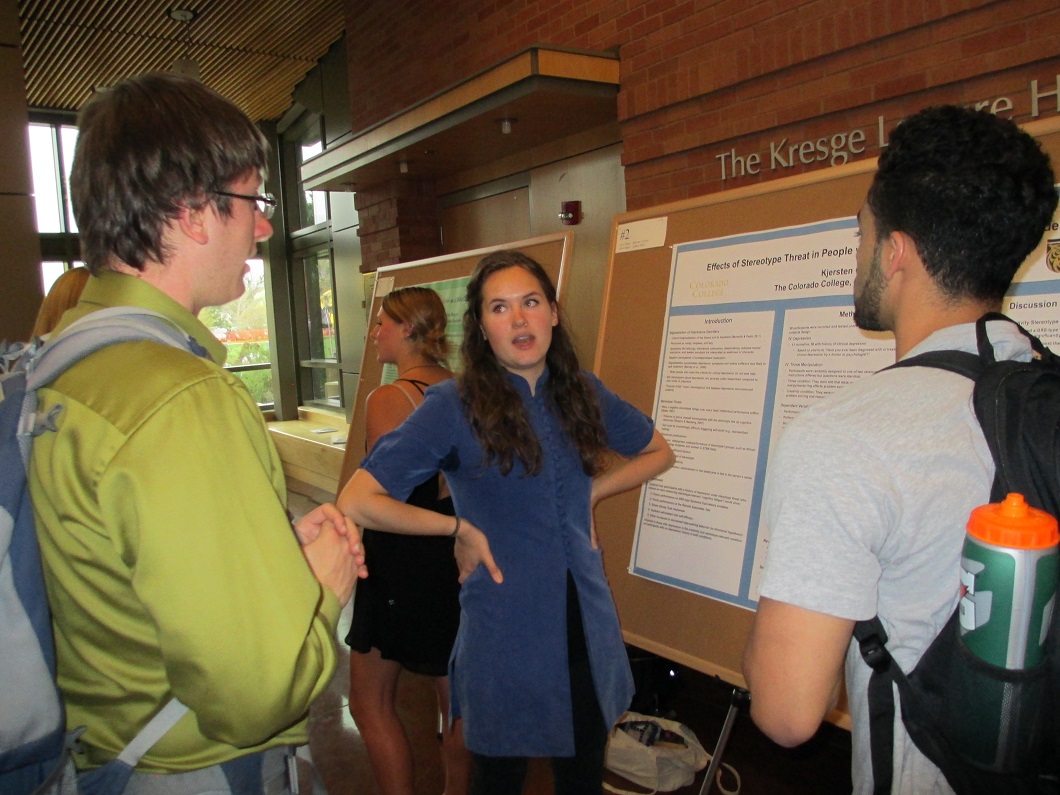
Psychology
Advisor: Emily Chan
Effects of Stereotype Threat in People with a History of Depressive Disorders
In this empirical study, we studied how stereotype threat affected the task performance, self-esteem, self-efficacy, and help-seeking behavior of people with a history of depression. Participants with or without a history of depression took a test with multiple tasks, and were assigned to either a stereotype threat condition (test was diagnostic of "mental fog") or a non-threat condition (test was diagnostic of creativity). We hypothesized that the stereotype threat group would exhibit executive resource depletion via a Stroop task, poorer verbal reasoning task accuracy, lower self-esteem, and lower self-efficacy. We did not have a directional hypothesis regarding how stereotype threat might affect help-seeking behavior. Data showed there was no negative stereotype threat effect on verbal reasoning task performance and speed, or on help seeking behavior. Self-esteem and self-efficacy were not affected by stereotype threat, but showed a main effect whereby participants with a history of depression scored lower on both measures. Surprisingly, for the main verbal reasoning measure, we found suggestive evidence for a stereotype boost effect for participants with depression who were told that the task was diagnostic of creativity. To our knowledge, this is the first empirical finding of its kind. Our findings underscore the need for further research on the content and impact of depression stereotypes.
Susannah Conway
Psychology
Advisor: Tomi-Ann Roberts
Bringing Unsexy Back: A Review of Protective Factors Against Sexualization and an Argument for Summer Camp
In 2007, the American Psychological Association published a report that presented compelling evidence of widespread cultural sexualization of the female body and the attendant negative effects on girls. When girls internalize the sexualizing and objectifying messages they are exposed to every day, they can experience a number of negative emotional, cognitive, and even physical consequences. Fortunately, a growing body of research suggests a variety of methods to help girls combat the negative effects of sexualization and self-objectification. This paper reviews the existing, though as of yet scant, literature on such methods. Research has shown that media literacy programs, sports participation, body-focused exercise, single-sex environments, and uniforms can all potentially protect girls from the negative effects of sexualization. Despite the evidence, however, these tools are not yet widely implemented or accessible. A proposal for an all-girls summer camp intervention, argued to provide an ideal venue for implementing effective methods for combating the negative effects of sexualization in girls, is provided.
Madeline J. M. Goldman
Psychology
Advisor: Tricia Waters
"Selection" Risk Factors for the Cohabitation Effect: Serial Cohabitation, Attitudes Towards Marriage, and Personality Characteristics
Premarital cohabitation has been associated with increased risk of marital dissolution due to coincident rising rates of cohabitation and divorce. This trend, deemed the cohabitation effect (Rhoades, Stanley & Markman, 2009), has been reasoned to be a function of risk factors categorized into either experience factors, which encompass the experiences of cohabitation, or selection factors, which are personal characteristics that cause an individual to "select" into a cohabiting relationship. Two hundred and twenty-six previously cohabitating individuals were surveyed to investigate the relationship between several selection risk factors (serial cohabitation, attitudes towards marriage and personality characteristics) and the cohabitation effect. Serial cohabitation was found to be associated with marital dissolution, whereas greater romantic attitudes increased marital success. Future studies should assess for gender differences in these trends as well as for unexplored characteristics that may also constitute selection risk factors for divorce in couples who engage in premarital cohabitation.
Jessica Gurrentz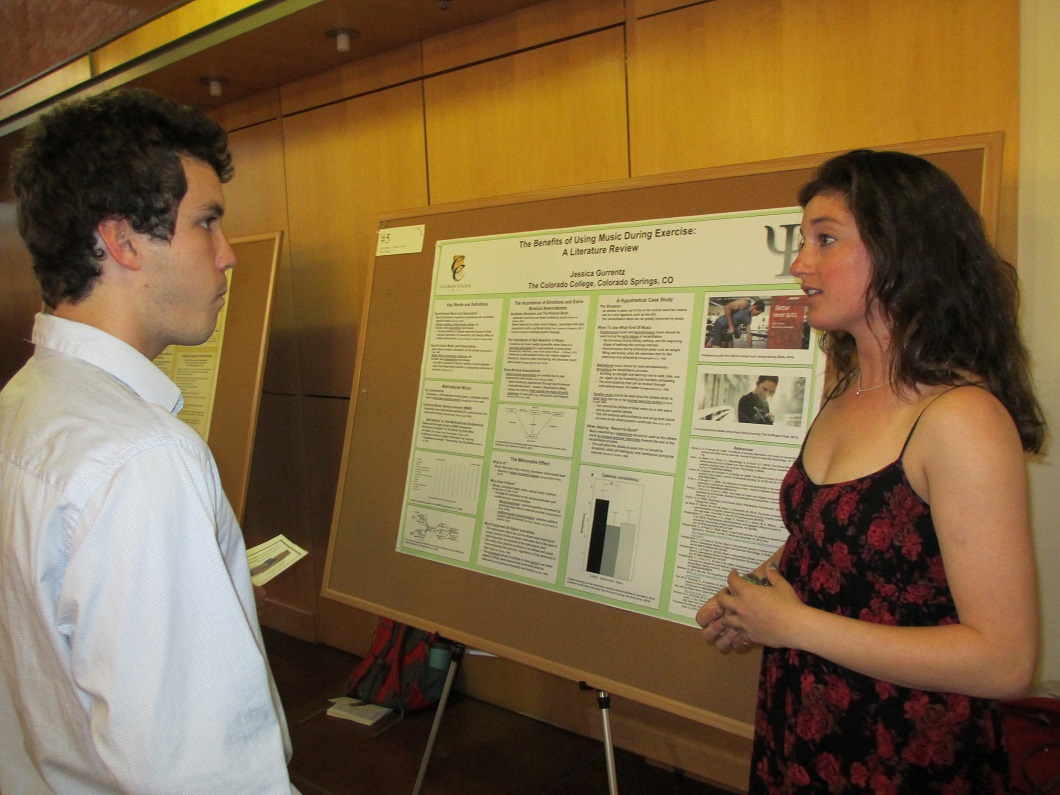
Psychology
Advisor: Kristi Erdal
The Benefits of Using Music During Exercise: A Literature Review
Music is known to be a beneficial asset to both professional and non-professional athletes. Certain types of exercise, such as those involving repetitive movements (e.g., running, cycling, etc.), respond more strongly to music that mimics consistent rhythms. Other types of exercise, such as those involving endurance (e.g., weight lifting, marathons, triathlons, etc.), benefit from music that provides a distraction. There are specific attributes of music that can guide athletes to their peak performance levels. These can include motivational aspects, such as lyrics, tempo, and volume; non-motivational aspects, such as simple tones providing background noise, or just consistent beats, such as those that may mimic a metronome. Music can both improve the output of an athlete's workout and improve an athlete's mood while reaching high levels of physical intensity. Application of these principles is discussed.
Margaret B. Harwood
Psychology
Advisor: Kristi Erdal
The Effects of Alcohol Abuse on Families: A Methodological Critique
Individuals who suffer from alcohol abuse problems not only experience aversive health effects, but also negatively impact those around them, specifically family members. Guardians with poor parenting skills put their children at an increased risk for a negative developmental trajectory socially, cognitively, and psychologically. Alcohol abuse can lead to poor spousal interaction, parental divorce, child neglect, and physical and sexual abuse and these in turn can adversely affect quality of parenting. Methodological limitations, social stigma, and fear of losing custody of their children has made it difficult for women, mothers specifically to participate in alcohol abuse research. Treatment should include everyone being affected by the alcohol-abusing person's behavior in order to make significant progress.
Cameron B. Johnson
Neuroscience
Advisor: Bob Jacobs
Neuronal Morphology of Prefrontal, Primary Motor, and Primary Visual Cortices in the Siberian Tiger (Panthera tigris altaica) and the Clouded Leopard (Neofelis nebulosa)
The present study investigates for the first time the neuronal morphology of Siberian tiger and clouded leopard neocortex. Previous investigations of large-brained mammalian neocortex have included such diverse species as the African elephant, giraffe, minke whale, humpback whale, and bottlenose dolphin. Neurons (N = 194) were traced in prefrontal, motor, and visual cortices for each species. Each neuron was quantified using six dependent measures: volume, total dendritic length, mean segment length, dendritic segment count, dendritic spine number, and dendritic spine density. Both felid species possessed expected spiny and aspiny morphologies. An inferential MARSplines analysis was able to differentiate typical pyramidal neurons between Siberian tiger and clouded leopard. Gigantopyramidal neurons in the Siberian tiger were larger than those observed in any other species to date. Comparatively, Siberian tiger typical pyramidal neurons were highly complex in terms of dendritic length and branching, on par with neurons traced in African elephant and humpback whale, two species of substantially greater brain mass. Future studies should continue seeking phylogenetic diversity among specimens in an attempt to elucidate those morphological qualities unique to each mammalian lineage. Doing so is a necessary step toward holistically understanding evolutionary and functional neuronal adaptations.
Robert V. Kasemodel
Neuroscience
Advisor: Lori Driscoll
The Effects of Exposure to PBDE-mixture DE-71 on
Ethanol Preference and Hormone Concentrations
Polybrominated diphenyl ethers (PBDEs) are flame retardant chemicals that are persistent, bio-accumulative environmental toxins. They pose a threat to humans due to their hormone-altering effects: they suppress thyroxine (T4) concentrations, disrupt androgen-dependent development, and influence sexually dimorphic behavior. Female rats tend to prefer sucrose to a greater extent than male rats, but male rats exposed to PBDEs demonstrate increased sucrose preference. The purpose of this study was to determine whether this effect represents a feminization of behavior or an increase in hedonic reinforcement. If the change in sucrose preference is due to hedonic reinforcement, changes in the consumption of drugs of abuse, such as ethanol, may also be expected. In the present study, rats were orally administered DE-71 (30 mg/kg and 60 mg/kg) once daily from PND 6 through PND 12 to determine the effects of acute neonatal exposure on T4 concentrations, testosterone concentrations, and ethanol preference. In addition to the DE-71 treatment, a levothyroxine (L-thyroxine) rescue was given to half the rats to determine if such a rescue could bring T4 concentrations back to baseline. Decreases in T4 concentrations in DE-71-treated rats compared to control rats were found, but the L-thyroxine rescue was ineffective in ameliorating this effect. Testosterone concentrations and ethanol preference were unaffected by treatment.
Anna Kisken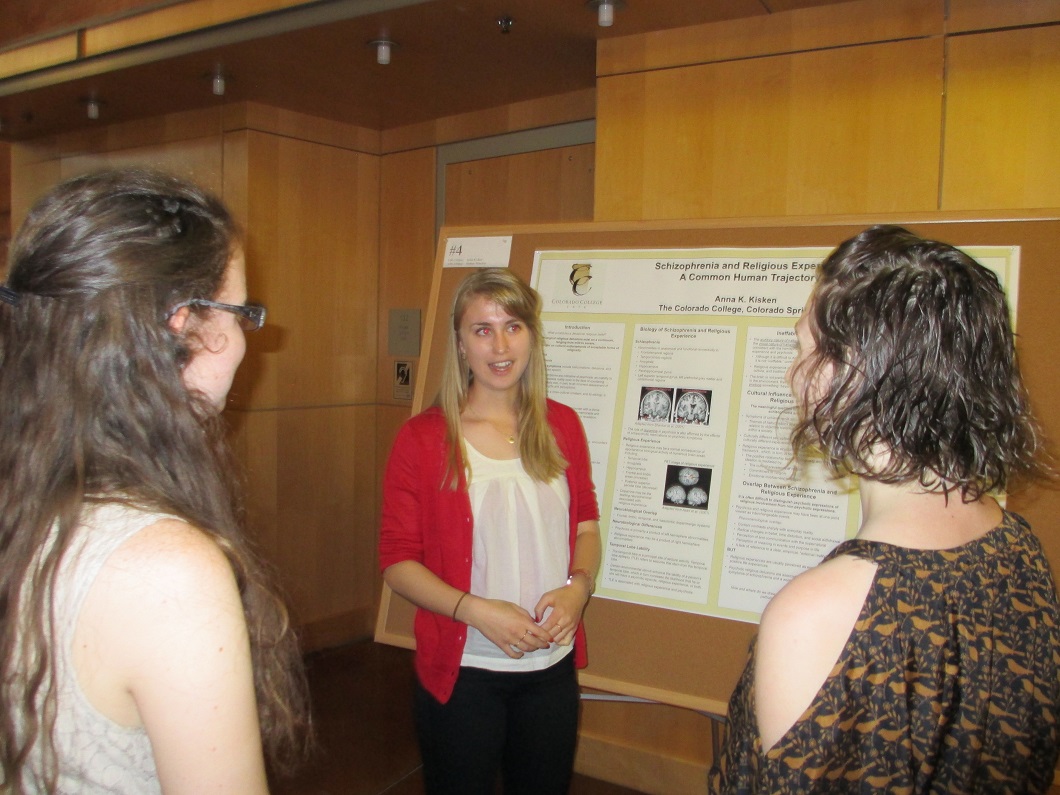
Psychology
Advisor: Kristi Erdal
Schizophrenia and Religious Experience: A Common Human Trajectory
Psychotic episodes in schizophrenia and religious experience are similar phenomenological events that occur throughout all human cultures. Despite having several shared neurobiological underpinnings, evidence suggests that the two are distinct but overlapping experiences. Cultural perspectives complicate current understandings of both experiences by highlighting the problem of pinpointing what constitutes a delusional religious belief. As such, pathological religious delusions exist on a continuum, ranging from mild to severe, that hinges on cultural endorsements of acceptable forms of religiosity. The evidence that religious beliefs may be beneficial to those with schizophrenia is contingent upon the ways in which affected individuals internalize religion and project religious themes onto their disorder as coping and/or explanatory mechanisms. Overall, psychosis and religious experience may be versions of a latent human ability to create or detect anomalous perceptual events, which function to reassure humans that there may be something beyond death.
Julia Liao
Psychology
Advisor: John Horner
Effects of Primed Self-Perceptions on Environmental Attitudes and Behavior
Pro-environmental self-identity is a strong predictor of pro-environmental attitudes and behavior. According to self-perception theory, reminding people of their past pro-environmental actions can increase their pro-environmental self-identity, which, in turn, increases their future levels of pro-environmental attitudes and behavior. In contrast, activating a pro-moral or economic self-identity has been associated with reduced levels of pro-environmental behaviors and attitudes. The present study extends past findings by inducing pro-environmental, pro-moral, or economic self-perceptions in participants in order to directly compare the effects of these self-perceptions on environmental attitudes and behaviors. Results showed no difference in post-manipulation attitudes or behavior between the three self-perception conditions. These findings suggest that the behavior-to-identity-to-behavior relationship may be less robust or straightforward than indicated in the existing literature, or that its effects may be waning as environmental awareness increases among the public. Future research is needed to explore the possibility that invoking past pro-environmental actions represents an increasingly ineffective strategy for encouraging future pro-environmental behavior.
Ainsley M. Lundie
Psychology
Advisor: Tomi-Ann Roberts
Who's Happier and Why? A Comparison Study Between Danes and Americans
For decades researchers and the popular press have named Denmark the happiest country. Danish happiness has been attributed to various benefits of living in Denmark itself, such as the social welfare state (ie. free healthcare, free education, and unemployment benefits), bicycle commuting, working less, paid vacation time, and paid maternity and paternity leave. The present study sought to examine whether personality variables might also contribute to Danes' greater happiness. Danes and Americans were compared in terms of their self-reported happiness, self-esteem and self-compassion. There was no significant difference between Danes and Americans on the measure of happiness. However, self-esteem was found to be a stronger predictor of happiness in the American sample, while self-compassion more strongly predicted the happiness levels of the Danish sample. A number of hypothesized cultural contributions to the differing definitions of "happiness" and the influence of self-esteem versus self-compassion to the happiness of Americans and Danes are offered.
Sydney Minchin
Psychology
Advisor: Tricia Waters
Language Development and the Acquisition of Self-Regulation Mechanisms: An Exploration of Language Disorders and Externalizing Behaviors
Children are often misdiagnosed or treated for behavioral problems that are characterized as disruptive, aggressive, or inattentive. What may be overlooked in these cases is the child's capacity for language. Language deficits often present as poor self-regulation (i.e., externalizing behaviors) in early and middle childhood. During this time a cycle emerges of breakdowns in communication and regulation pathways contributing to externalizing behaviors. Transition to school gives way to further problems if language deficits are not treated when they first present: poor peer interactions, peer rejection, and the possible development of aggressive tendencies and thoughts. This paper explores the relationship between language and self-regulation and examines how these systems are negatively impacted in children with language disorders. Discussion focuses on the implications for socio-emotional functioning as these children transition through childhood and into adolescence. A variety of intervention techniques are reviewed that target specific aspects of language disorders, externalizing behaviors, and aggressive thoughts. The paper concludes with an extensive discussion of my field placement in an Early Head Start classroom where I worked with a two-year-old with language deficits. I conclude that language proficiency is necessary for the development of self-regulatory mechanisms.
Dylan Mohr & Brian Kopec
Neuroscience
Advisor: Bob Jacobs
Comparative Apical Dendritic Morphology in the Neocortex in Afrotherians, Carnivores, Cetartiodactyls, Primates, and Rodentia
The six-layered neocortical organization of the rodent/primate model is characterized by a columnar structure running orthogonal to the layers, consisting of vertically ascending apical dendrites. Thalamic afferent projections to the granular cells of layer IV provide the basis for the integrated columns, which are thought to help synchronize signals during cortical processing. Despite the vast amount of research describing the relationship of pyramidal neurons to cytoarchitecture within the rodent/primate model, few quantitative analyses have focused on the apical dendrite. Recent insight into the laminar organization of several phylogenetic groups (e.g., afrotherians, cetartiodactyls) has revealed an organizational pattern that differs from the canonical rodent/primate model, displaying an absence of a visible granular layer IV. Qualitative observations of pyramidal neurons within these species suggest an apical shaft that bifurcates relatively close to the soma to form widely ascending branches, however, no quantitative measures have been recorded. To this end, the present study quantified five dependent measures, (1) apical to bifurcation distance (2) branch angles at 20 μm, (3) 40 μm, and (4) 60 μm and (5) lateral spread, in the neocortical pyramidal neurons of two groups of mammalian species, those with a visible granular layer and those without. Descriptive statistics revealed a continuum for measures (1-4) with the rat and African elephant emerging as the maximum and minimum ends. Although the differences between the two groups may be too subtle when examined across such a large number of species, the findings suggest that pyramidal neurons may have underwent phylogenetic adaptation in mammals with relatively low neuronal cell density and an absent granular layer.
Claire Myerscough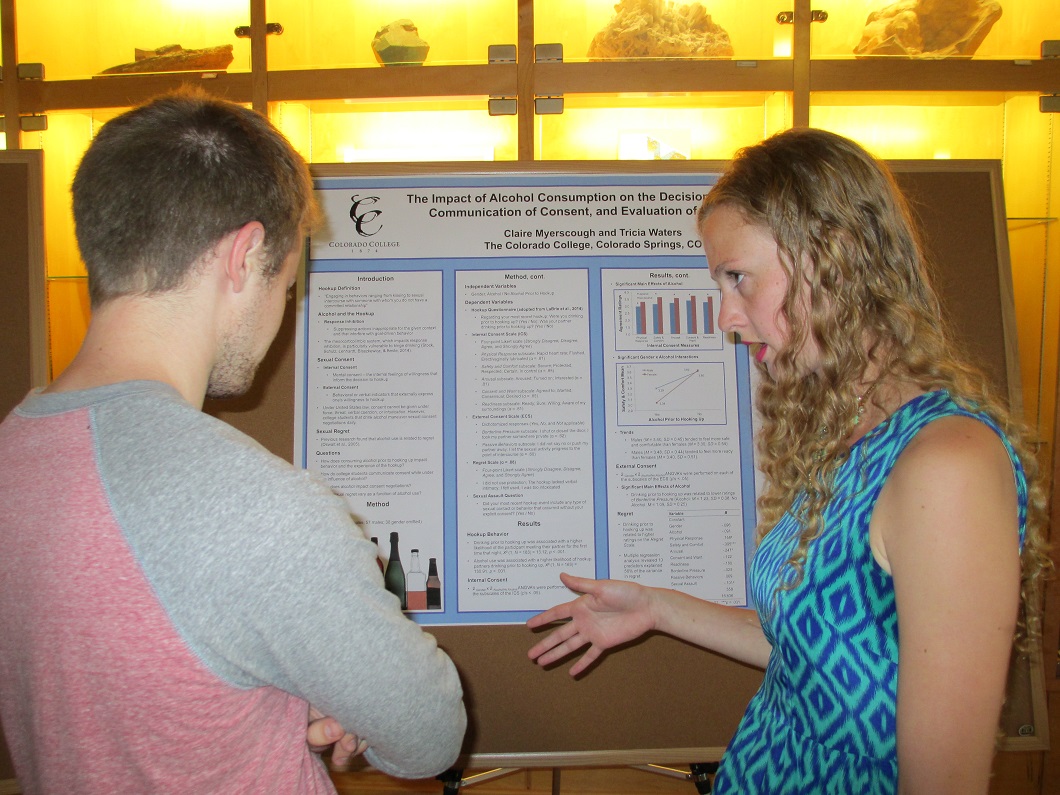
Psychology
Advisors: Tricia Waters
The Impact of Alcohol Consumption on the Decision to Hookup, Communication of Consent, and Evaluation of the Event
The current study used event-level analyses to investigate the impact of alcohol on hookup behavior, consent, and regret. One hundred and ninety-five undergraduates completed an online survey regarding their most recent hookup. Fifteen percent of participants reported a hookup involving sexual assault. Drinking prior to hooking up consistently predicted lower ratings of internal consent compared to non-drinking participants, and few gender differences emerged from the sample. Regret analyses indicate the influence of alcohol on behavior is more important than the amount of alcohol consumed. Sexual assault prevention efforts and sexual education should focus on the negative impact of alcohol on all levels of contentment with the decision to hookup.
William Rushton
Psychology
Advisor: Kevin Holmes
The Role of Artistic Experience in Holistic Processing of Faces
The difficult task of discriminating and recognizing faces is mitigated by the human tendency to process faces holistically, as unified wholes. Holistic processing (HP) relies on configural information between object parts to match perceptual features to a unique identity. The extensive body of research on HP is generally in agreement about the factors that give rise to the phenomenon. However, recent correlational research on the role of artistic experience in HP suggests that artists with considerable experience drawing human faces show lower levels of HP. The current study attempted to clarify the relationship between HP and artistic experience by assessing HP in 21 college students before and after an introductory drawing class or a non-art-related control class. The results showed no evidence of reduced HP in the art students compared to the non-art students, suggesting that individual differences in HP may be preexisting rather than driven by artistic experience. A significant negative correlation between HP and face memory capabilities was also observed, contrary to previous research showing a positive relationship between the two. These findings suggest two pieces of information: artistic experience does not influence levels of HP and lower levels of HP leads to face memory capabilities.
Logan Savidge
Neuroscience
Advisor: Tricia Waters
Gender Differences in Undergraduate Students' Motivation: What Motivates Males and Females to Pursue STEM Subjects?
The current study investigates gender differences in the way motivational variables such as expectancy, value, cost and overall motivation predicted student achievement and future interest in STEM courses. Ninety-four students enrolled in introductory psychology courses at a small liberal arts college volunteered to participate in the survey; sixty percent of the sample identified as female and 40.4% identified as males. Females reported significantly higher overall motivation, value, and cost in relation to the course than males indicating differences in the way each gender perceives this course. Multiple regression analysis revealed gender differences in the predictability of measured variables for future interest in STEM courses. Additionally, multiple regression by gender revealed that expectancy, value, cost, achievement and overall motivation explained more of the variance in men's future interest in STEM courses than women's. Overall, the results suggest that males and females may be motivated by different variables interacting in different ways. For example, males' perceived valuation of introductory psychology was an independent predictor of their future interest in STEM courses, while females appeared to be motivated by a combination of variables. Future research needs to be done to determine whether there are other possible variables for females (as value is for males) that may be direct predictors of future interest in STEM.
Emma T. Schiestl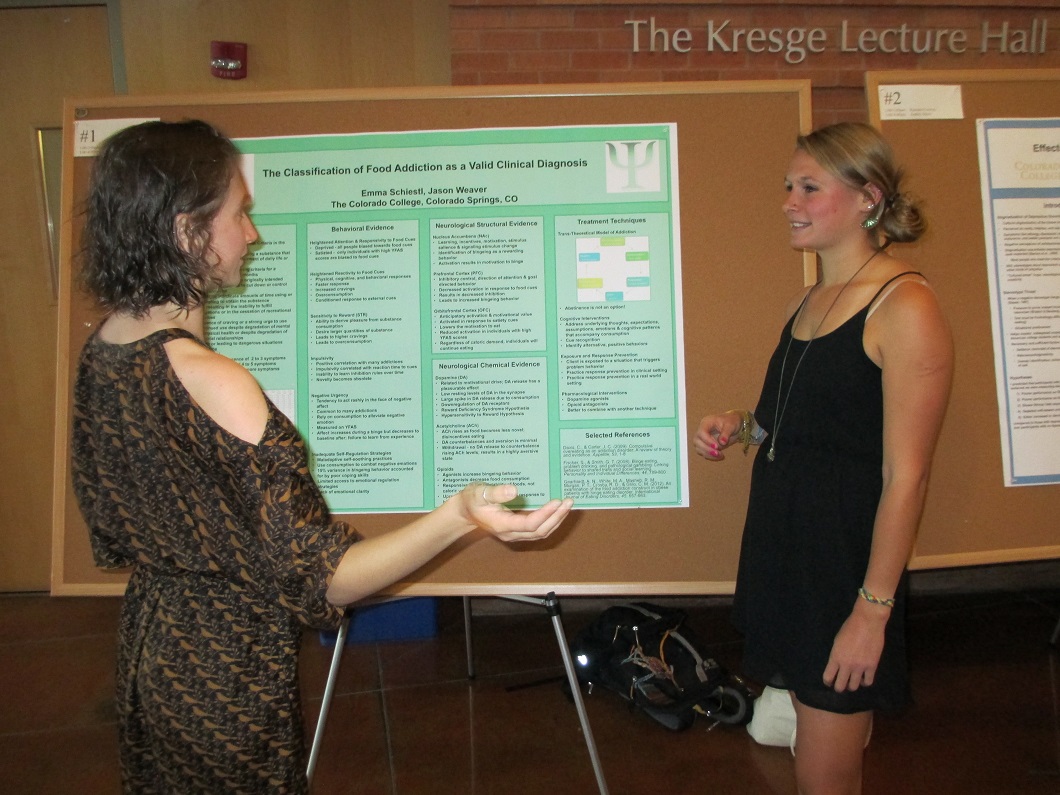
Psychology
Advisor: Jason Weaver
Behavioral and Neurological Evidence for Classifying Food Addiction as a Behavioral Addiction
As the acceptance of behavioral addictions continues to grow in the scientific community, the dispute about the validity of food addiction as a clinical diagnosis is being hotly disputed. Proponents of a food addiction diagnosis believe, based on the similarities between food addiction and substance use disorders, food addiction is a valid diagnosis. Specifically, this paper examines the similarities in behavior, neurological activation patterns, brain structure, and treatment techniques between people with substance use disorders and people with food addiction symptoms. Because people with food addiction symptoms demonstrate similar behaviors, such as heightened sensitivity to reward and increased responsiveness to food cues, show abnormal dopamine, opioid, and acetylcholine activation patterns in the nucleus accumbens, the prefrontal cortex, and the orbitofrontal cortex, and respond to specific treatment techniques like cognitive interventions and exposure and response prevention, just as traditional substance use disorders do, I argue that food addiction should be classified as a clinical disorder. Furthermore, because these symptoms occur in response to the behavior of excessive overconsumption rather than the consumption of a specific substance, I contend that food addiction should be classified as a behavioral addiction rather than a substance use disorder.
L. Parker Schiffer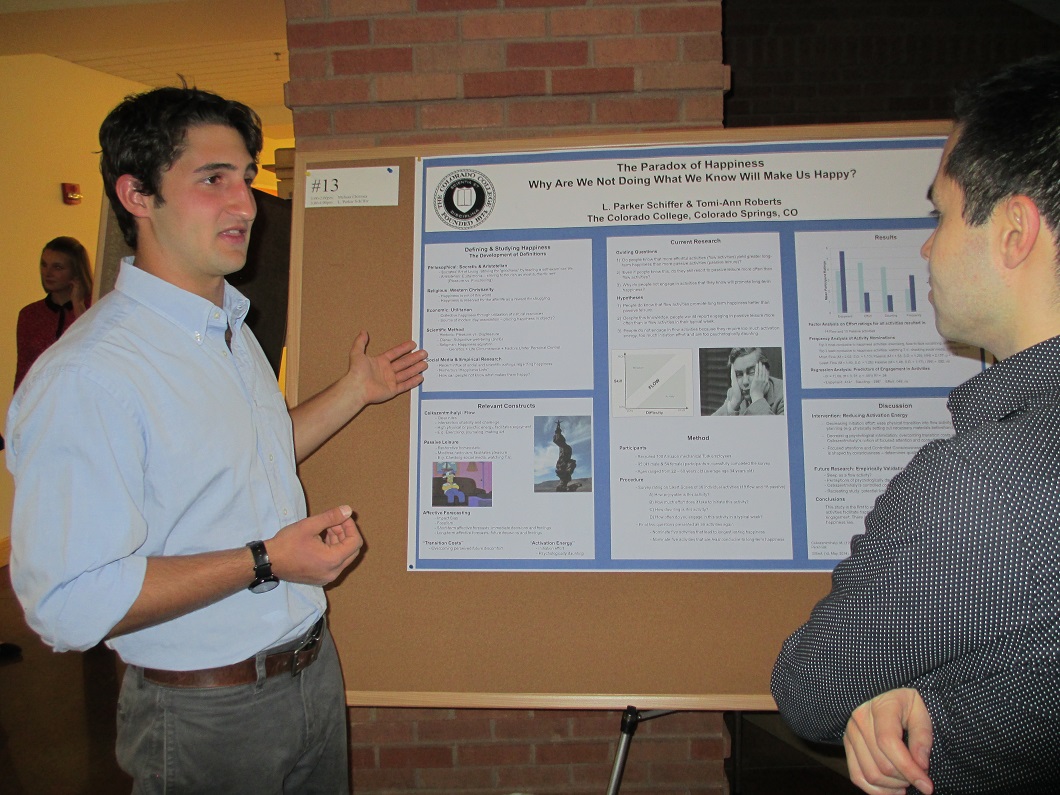
Psychology
Advisor: Tomi-Ann Roberts
The Paradox of Happiness: Why Are We Not Doing What We Know Will Make Us Happy?
Achieving happiness and maintaining positive well-being can be difficult, especially when people are not engaging in the activities they know to facilitate it. "Flow" activities require clear rules, challenge, a high investment of psychic energy, and have been empirically shown to promote long-term happiness better than low investment, passive activities. But do people know this? This study found that, despite nominating flow activities as more likely to facilitate long-term happiness, people nevertheless participated in passive leisure significantly more often in a typical week. Participants rated passive leisure activities as being significantly more enjoyable, as requiring significantly less effort, and as being significantly less daunting to get started than flow activities. Furthermore, participants' weekly engagement in the various activities was significantly predicted by how enjoyable activities were perceived to be, whereas their non-engagement was predicted by how daunting activities were rated. Suggestions for enabling people to rise above their affective forecasting errors, as well as the activation energy and perceived transition costs of engaging in flow activities are offered.
Audrey Sileci
Psychology
Advisor: Emily Chan
Teaching Neuroplasticity to Change Mindsets and Increase Resilience in Low SES Brazilian Adolescents
This directed field study tested the effectiveness of Dweck's framework of mindsets for students of low socioeconomic status in São Paulo, Brazil. This framework, developed in the US to increase resilience and improve academic achievement, identifies a difference between students with a fixed mindset (believing personal qualities such as intelligence and personality are fixed) and students with a growth mindset (believing personal qualities are malleable). Data from the study supported the mindset framework. Low SES students from a high-achieving school showed greater growth mindsets than students in a low-achieving school, who instead showed fixed mindsets. The students differed on their beliefs about the malleability of intelligence and personality, effort beliefs, and ability-approach goal orientation. Thirty students participated in a 150 minute neuroplasticity knowledge curriculum, modeled after Brainology (Mindset Works Inc., 2008), and as predicted the intervention increased the growth mindsets of the students. The intervention affected the core dependent variables tested, demonstrating the potential for its long-term effects in Brazilian students if the duration of the intervention can be extended.
Andrea Stephens
Psychology
Advisor: John Horner
Homo Economicus' Performance on Social Value Orientation and Psychopathy Measures: Support for Quasi-Homo Economicus?
Homo economicus is a rational pursuer of self-interest, characterized by a disregard of others' welfare when making decisions. This lack of empathy for others is often thought of as being a trademark of psychopathy. However, irrationality is also thought to be part of a psychopath's personality, and Homo economicus, by definition, should be utterly rational. Another non-cooperating entity, quasi-Homo economicus, is thought to be similar to Homo economicus in their disregard for others, but is characterized as being highly impulsive, thus having the irrationality trait Homo economicus lacks. In this comparative study, participants were behaviorally classified as Homo economicus, quasi-Homo economicus, or cooperatiors through choices made on Prisoner's Dilemma and dictator games. Members of these three groups then completed a Social Value Orientation Scale (SVO), Primary Psychopathy Scale, and Secondary Psychopathy Scale. Significant differences were found between groups on SVO and Primary Psychopathy. Some evidence for differences on the Secondary Psychopathy Scale, which measures impulsivity, was also found. Cultural impact on cooperation, economic repercussions, and directions for future research are discussed.
Jake Sullivan
Psychology
Advisor: Tomi-Ann Roberts
Cognitive Broadening and the Other-Praising Emotions
Experiencing a positive emotion like joy or mirth leads to cognitive broadening, which in turn causes people to engage in behaviors which build lasting personal resources. This experiment extended the work on cognitive broadening to the other-praising emotions, a subset of positive emotions which focus on another person rather than one's self. Given that the other-praising emotions can promote self-disinterested behavior, it was hypothesized that they would cause a greater amount of broadening than joy. One hundred seventy six people recruited through Amazon Mechanical Turk completed a memory induction to experience either joy, elevation, gratitude or a control calm emotion and completed five measures of cognitive broadening. No significant differences were found between broadening caused by joy and broadening caused by the other-praising emotions. Positive emotions cannot be fine-grained according to the amount of cognitive broadening they cause, and future work should examine other differences between classes of positive emotions which can help account for the different appraisals and behaviors that they promote.
Jordyn Watts
Neuroscience
Advisor: Lori Driscoll
Effects of Brief Postnatal PBDE Exposure on GABA-Dependent Behaviors in the Rat
Polybrominated diphenyl ethers (PBDEs), a class of flame retardant compounds used in polymer products such as polyurethane foam and plastics, have become ubiquitous in the environment. Exposure to PBDEs produces endocrine disrupting and neurobehavioral effects. Previously, investigators in our laboratory have noted that rats exposed postnatally to the commercial PBDE mixture DE-71 require higher doses of pentobarbital (a γ-aminobutyric acid type A, GABAA, receptor agonist) than control rats to reach the same level of unconsciousness for surgical procedures. It is unknown whether this hyposensitivity to pentobarbital is due to receptor level or metabolic changes. Therefore, the current study explored the effects of brief (postnatal days 6-12) DE-71 exposure on anxiety and on open field behavior, both of which are modulated by GABAA receptors. In addition, changes in open field behavior in response to a pentobarbital challenge were measured as a proxy for GABAA receptor function. Male and female Long Evans rats were exposed postnatally to 0, 30, or 60 mg/kg DE-71 per day. No treatment effects were found on an elevated plus-maze measure of anxiety. Locomotor behavior was dose-dependently decreased by pentobarbital in the open field, but the magnitude of the effect was not altered in the DE-71 treatment groups. To determine if rats exposed to DE-71 metabolize pentobarbital differently than do control rats, blood was collected via cardiac puncture at several time points following a single dose of pentobarbital. The serum pentobarbital kinetic data are pending.
Carrie Ann White
Psychology
Advisor: Kristi Erdal
Cognitive and Emotional Empathic Deficits in Psychopathy: Theoretical Models and Treatment Strategies
Psychopathy, characterized by a constellation of impairments including lack of impulse control, guilt, or remorse, is commonly perceived as an untreatable personality trait. However, intervention may be possible with targeted strategies based on a thorough understanding of one of the most profound impairments associated with psychopathy: a pronounced lack of empathy. I will consider the relative roles of cognitive and emotional empathic impairment in psychopathic individuals, based on empirical and neurological evidence. Subsequently, I will reconcile the empirical findings with common theoretical models and pose suggestions for future directions and implications for treatment. Treatment strategies are based on a thorough understanding of the multidimensional definition of empathy as it relates with psychopathy, as well as a comparison between psychopathic empathic deficits and empathic deficits which have been shown to relate to autism spectrum disorder (ASD), for which many treatment strategies are already in place.
Wan Hung "Harry" Yau
Psychology
Advisor: John Horner
How Explicit Knowledge of an Underlying Process Affects Our Ability to Detect Change
Explicit learning is the foundation of the education system, yet past research has produced contradicting results on how explicit knowledge affects performance. There is a general assumption that explicit knowledge helps with performance in simple, deterministic tasks, but has no effect or hurts performance in complex conditions. This experiment aimed to explore how explicit knowledge of an underlying process affected our ability to detect changes in that process. Participants were first introduced explicitly to the underlying process, then they would enter a training phase and testing phase, where the testing phase was designed to explore the relative ability of detecting changes in different deviation conditions. There appeared to be two distinct patterns of discriminability: the Addition and Agrammatical conditions appeared to be much more discriminable, but the Subtraction and Probability Shift conditions appeared similar to control condition, which was when there was no change in the testing phase. This supported the claim that explicit knowledge helps with simple task but interfere in complex condition. Therefore, while explicit learning is the foundation of the education system, the importance of implicit learning should be empathized to develop a more adaptable and comprehensive knowledge system.
Samuel Zarky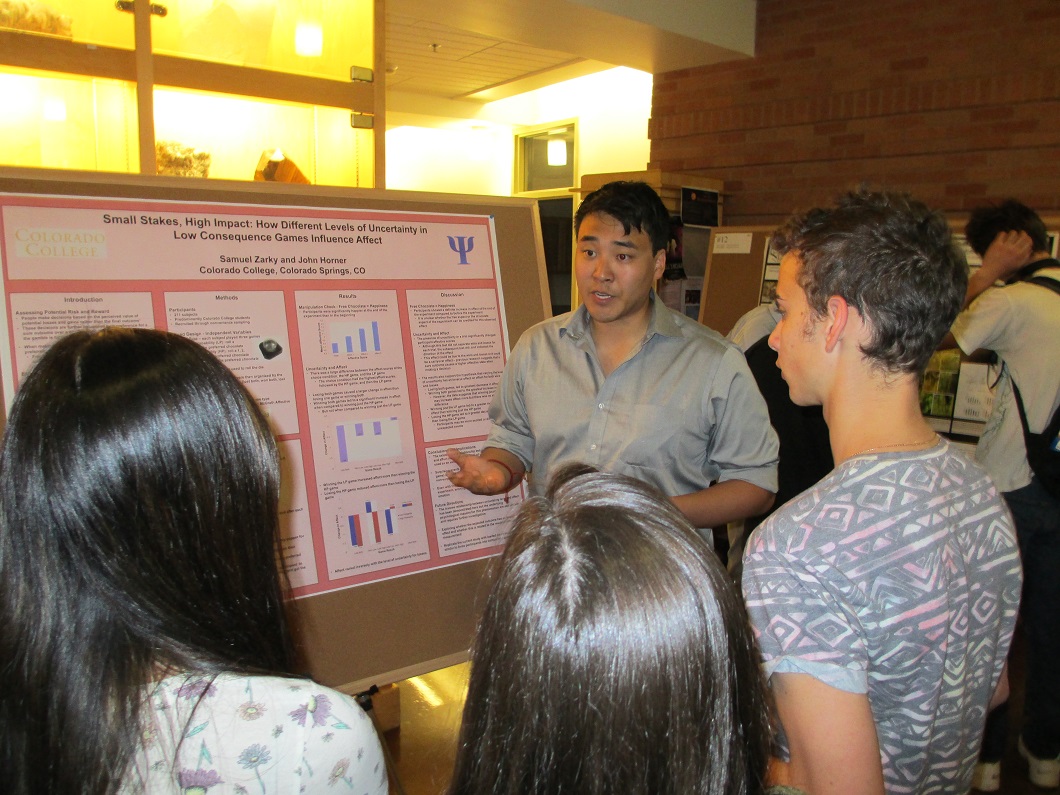
Psychology
Advisor: John Horner
Small Stakes, High Impact: How Different Levels of
Uncertainty in Low Consequence Games Influence Affect
The link between affect and probabilistic outcome was explored by subjecting participants to games with varying levels of uncertainty and providing different prizes depending on the outcome. The majority of past research on emotion and decision-making explored how emotional state can influence risk-taking behavior and decision making both directly and indirectly. Little investigation has been conducted on how the outcomes of these choices can impact emotion. The present research narrows this gap by demonstrating both the direction and magnitude of this relationship. Two hundred eleven college students participated in three types of games: choice, low probability, and high probability. Affect was measured before experimentation and then again after each of the game types. There was a marginally significant main effect of the type of game and participant affect. As hypothesized, participants who lost just the high probability game experienced a greater decrease in affect than participants who lost only the low probability game. However, participants who won just the low probability game did not experience a significantly greater increase in affect when compared just the high probability game or both games. It was concluded that winning the low probability game led to a larger increase in affect than winning the high probability game and similarly, losing the high probability game elicited a larger decrease in affect than losing the low probability game.
Hadar Zeigerson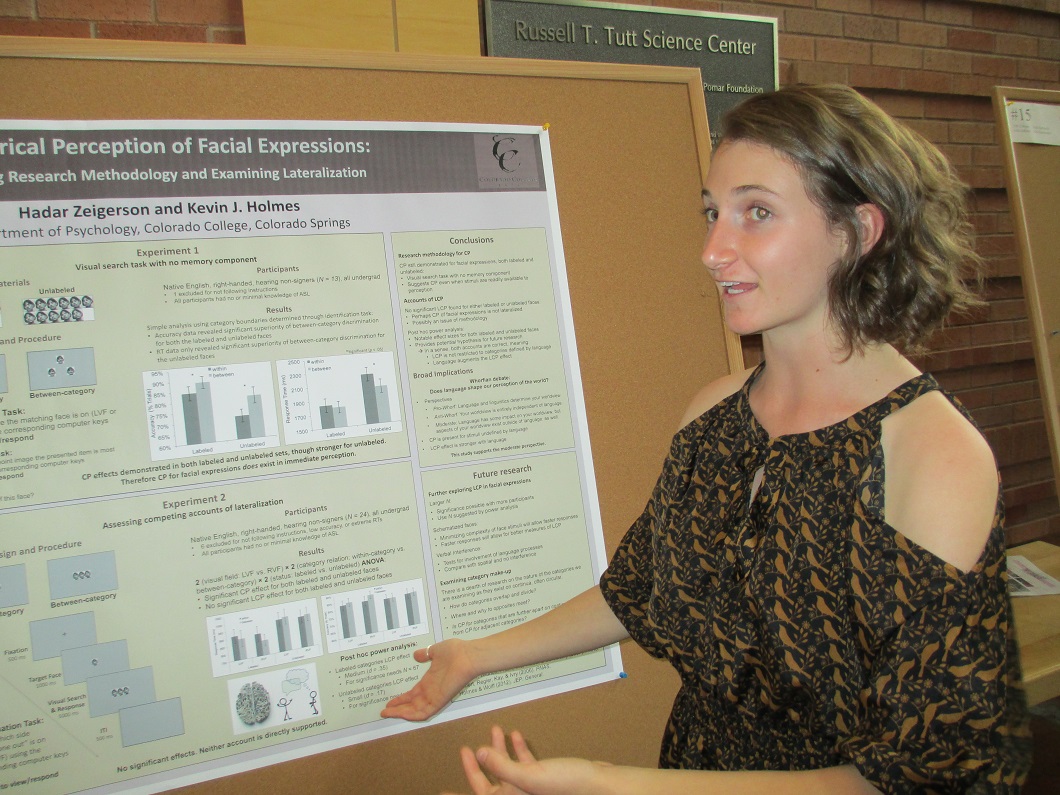
Psychology
Advisor: Kevin Holmes
Categorical Perception of Facial Expressions: Improving Research Methodology and Examining Lateralization
Categorical perception (CP) is the phenomenon by which category knowledge influences perceptual discrimination, and has been observed for a variety of visual stimuli including colors, objects, and facial expressions. Previous studies on CP of facial expressions have used paradigms involving memory demands, regarded by some critics as invalid measures of CP. Additionally, recent studies have found CP to be stronger in the right visual field (left hemisphere) than the left visual field (right hemisphere), a pattern consistent with two competing accounts: the language-driven account (which asserts the categories of LCP to be driven by language) and the category-driven account (which asserts the categories of LCP to be driven by categories that transcend language). The present research used improved, valid methods to test CP of facial expressions, and tested for LCP-not previously shown for facial expressions-to assess the two competing accounts. In Experiment 1, CP for facial expressions was measured using a visual search task with no memory component, and reliable CP effects were found for both labeled and unlabeled facial expressions. In Experiment 2, LCP was measured and the results for the labeled and unlabeled categories were compared. No significant effects of LCP were found for either set of categories. However, a post hoc power analysis revealed a weak LCP effect for both sets, albeit stronger for the labeled categories. Implications for specifying the mechanisms underlying CP, LCP, and effects of language on thought are discussed.
show all / hide all


